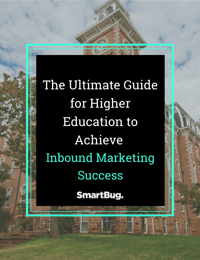
4 Lead Generation Strategies for Higher Ed Using Inbound Marketing
July 27, 2021
The higher education industry contributes significantly to growth of the economy, and it was one of many industries heavily impacted by the COVID-19 crisis. With growing demand for online and virtual schooling, higher ed continues to grow in market size, estimated to hit $2,367.51 billion in only five years.Future students are researching higher ed opportunities online, and there are several lead generation strategies you can implement using inbound marketing. Let’s explore a few.
1. Content Marketing
Students are going to choose a higher ed organization that “fits”—their budget, their values, and their interests. In choosing that perfect fit, students will research online to look at different programs available, class formats, financial aid options, scholarships available, and so much more.
Attract Interest
You can make your higher ed organization stand out by creating content that answers questions the students are asking. A few of these questions might include:
- What programs are available?
- Are classes in person, online, or hybrid?
- What is the cost of a credit hour?
- Are classes taught by professors or teaching assistants?
- What is “off-campus” life like?
Start a blog on your higher education website, and aim toward answering some of these important questions. When prospective students are researching online, they’re likely to stumble upon your website if you’re sharing relevant content. But just because a student lands on your website doesn’t mean they’re now a lead in your database; you still have to capture their information.
Present Conversion Opportunities
Getting them to your website is the first step, and offering them a means to convert on your website is the second. Relevancy is key.
Let’s say you published a blog titled “5 Tips When Applying for Financial Aid.” When a reader gets to the bottom of that blog post, best practice is to call them to take action. You can do so by placing a call to action (CTA) at the bottom of the post. That CTA should direct to a gated landing page, meaning the student needs to fill out their information in order to access the content “behind the gate.”
Case Study: Southern Nazarene University
Content marketing is one factor that helped Southern Nazarene University increase year-over-year applications by 29 percent. Take a look at this example from their higher ed blog. The title of the article is, “What Age Is the Best To Enroll in Adult Education?” At the bottom of the post, there’s a CTA that leads to a gated guide on financial aid.
When implementing this lead generation strategy in higher ed, keep in mind that students will only be willing to exchange their information for content that is valuable to them—so make sure the topics you’re writing about are addressing their pain points.
2. Social Media
Many of your prospective students are connecting with others through social media. In fact, Pew Research found that 7 in 10 Americans are engaged on at least one social media channel. Better yet, TargetX found that 58 percent of prospective students research schools they’re considering on social channels.
In order to get more leads into the hands of your enrollment counselors, join in on the conversation. A few ways to get involved on social media:
- Join Facebook and LinkedIn groups that are relevant to your university’s program offerings; start conversations and respond to forums already out there.
- Run a contest on Instagram for prospective students (example: share a photo of you on campus using a specific hashtag and get entered for a chance to win).
- Share stories of current and past students. Why did they pick your school? What program are they in? What extracurricular activities are they involved in? What has their experience been like? Social media allows you to add a more humanized element into your higher ed marketing.
Looking for more resources? Check out LinkedIn’s resource center specifically built for Higher Ed Professionals.
3. Website Optimization
While sharing the right content and maintaining a social presence can get prospective students to your website, in order to get them to convert, you need to make sure students can find what they need quickly.
Organization
This starts with clear navigation and an easy-to-follow homepage. Here are a few best practices we recommend you follow:
- Limit your primary navigation bar to seven topics (i.e., academics, admissions, financial aid, diversity and inclusion, campus life, athletics, contact).
- Strategize the order of menu items (i.e., keep “Contact” on the right).
- Use straightforward language when naming your primary navigation menu items.
Conversion Optimization
You should also ensure your website is optimized for conversion opportunities. Is there a sticky “contact us” option that follows the student down the page as they scroll? Is there a more top-of-funnel call to action (i.e., a CTA that encourages the download of a short guide or checklist)?
Simplicity and Clarity
Most importantly, and with the exception of your homepage, ensure that each page on your website answers a single question. When the page is clear and relevant to the students’ needs, they will be more likely to give you their information—which leads me to one more conversion opportunity ...
4. Live Chat and Chatbots
The pressures of today’s world are demanding. Students are pressed for time and looking for answers to their questions promptly—they don’t want to pick up the phone, or send an email and wait for a reply. That’s why chatbots and live chat provide so much value.
With a marketing automation or chat tool, you can help students get answers to their questions in real-time. Live chat allows them to type back and forth with a real staff member who is readily available to help. If your institution doesn’t have the bandwidth to support live chat, chatbots are another great lead generation strategy for higher ed.
We recommend coming up with a list of frequently asked questions and building a chatbot strategy around those questions. With both live chat and bots, you can start the conversation by capturing the student’s first name and email in case you get disconnected. You can then reply to their questions in real-time, providing immediate value.
Embrace the Online Space
It’s time to embrace inbound marketing and a digitally driven approach to reach students in online spaces. By implementing these lead generation strategies in higher ed, you can make more progress toward the goal of getting qualified student leads into the hands of your enrollment counselors.
Learn more in our Ultimate Guide for Higher Education to Achieve Inbound Success.

About the author
Aubreigh Blair is the SVP, Client Operations for SmartBug. After being introduced to HubSpot in 2014, she began implementing the inbound methodology for both B2B and B2C clients. Aubreigh has experience in a variety of industries including SaaS, financial services, manufacturing, automotive, healthcare, and senior living. Today, she strategizes and implements operational efficiencies to align internal teams, with the ultimate goal of driving revenue growth. Read more articles by Aubreigh Blair.









